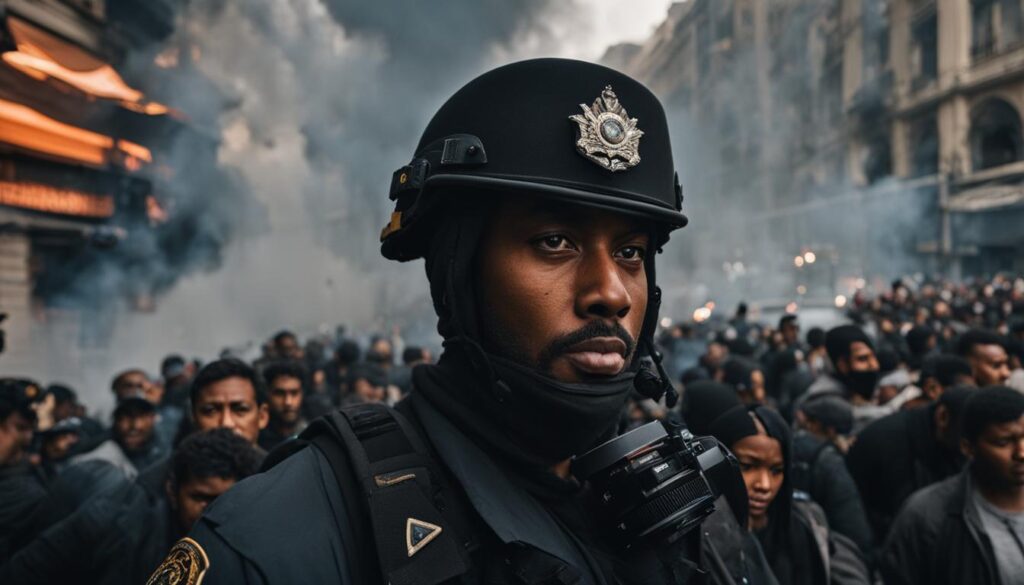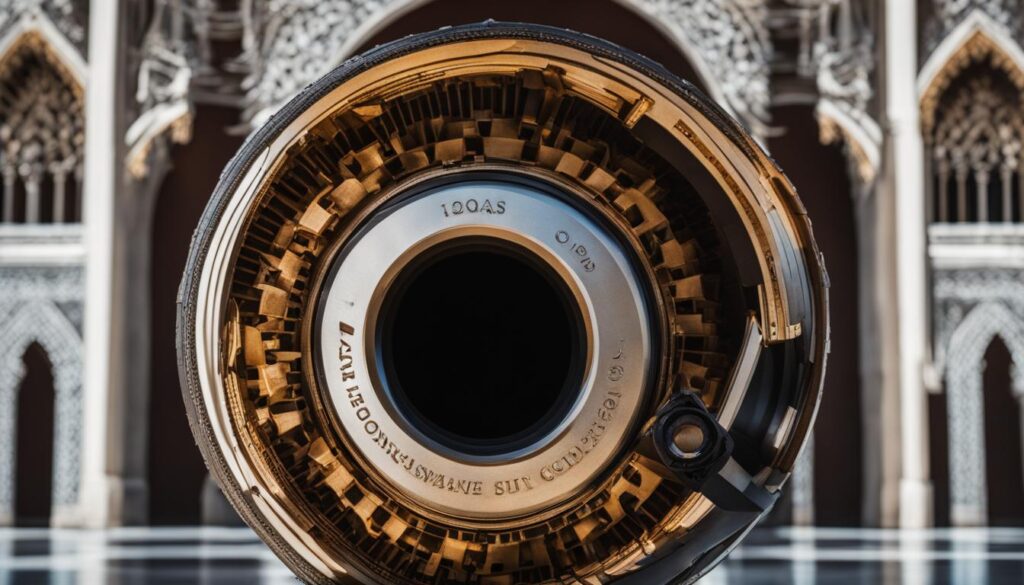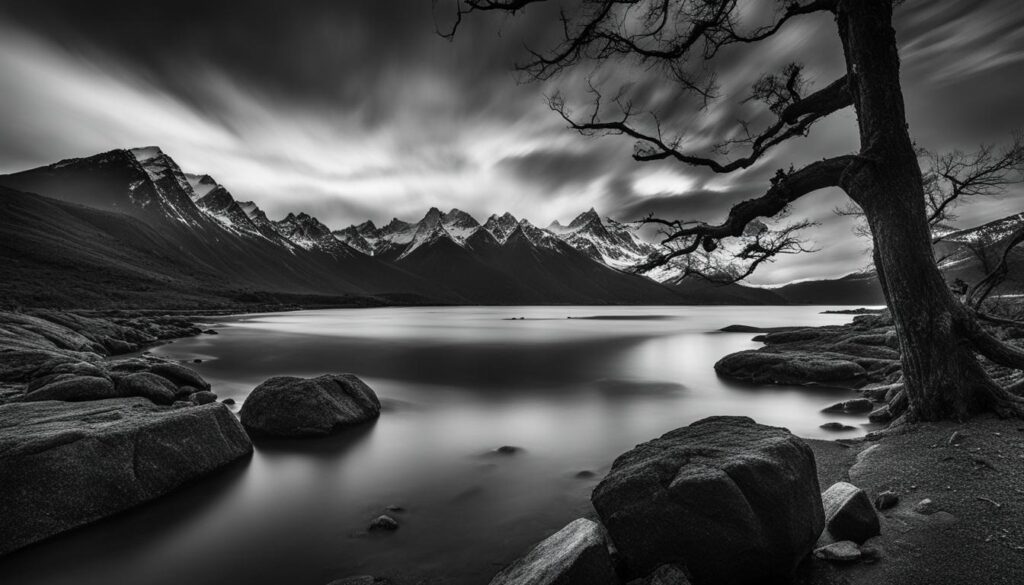We may earn money or products from the companies mentioned in this post.
Photojournalism is a form of visual storytelling that has the power to connect people, evoke emotions, and inspire change. Through powerful images, photojournalists are able to capture and convey stories that words cannot express, bringing attention to important issues and events from around the world.
In this section, we will explore the world of photojournalism, examining its significance, techniques, and ethical considerations. We will also examine the art of visual storytelling and highlight inspiring examples of photojournalism that have made a lasting impact on society.
Key Takeaways:
- Photojournalism is a powerful tool for visual storytelling that can evoke emotions and inspire change.
- Through techniques such as composition and narrative structure, photojournalists tell stories that words cannot express.
- Adhering to ethical principles is crucial when documenting and disseminating news events through visual storytelling.
- Building a career in photojournalism requires skills, education, and experience, as well as a willingness to adapt to changes in the industry.
- The transformative power of images is undeniable, and photojournalism has the ability to inform, inspire, and provoke change.
Understanding Documentary Photography
Documentary photography is a subgenre of photojournalism that aims to chronicle real-life events and situations. While photojournalism focuses on news and current affairs, documentary photography encompasses a broader scope, documenting various social, environmental, and cultural issues.
Documentary photography and photojournalism share a common goal: to inform and educate viewers about events and occurrences that shape our world. However, documentary photography places a stronger emphasis on visual storytelling and the presentation of a narrative that transcends individual news stories.
Photojournalism Examples
Some renowned photojournalists who have used documentary photography techniques to create powerful images that tell compelling stories include:
| Photographer | Notable Work |
|---|---|
| Dorothea Lange | “Migrant Mother” (1936) |
| Sebastião Salgado | “Workers” (1993) |
| James Nachtwey | “The Sacrifice” (1991) |
These photojournalists have captured moments in history that have helped shape our understanding of the world around us. Their images were not only aesthetically pleasing but also informative and challenging, provoking viewers to think critically about the social and political implications of what they saw.
Documentary photography has a powerful capacity to evoke empathy and spark action. By depicting the world in an honest and transparent way, these images can inspire meaningful change and draw attention to issues that might otherwise go unnoticed.
Mastering Photojournalism Techniques
Photojournalism is a powerful form of storytelling that requires skill, technical knowledge, and a deep understanding of the subject matter you are documenting. In this section, we will provide you with valuable insights into the techniques employed by professional photojournalists, so you can enhance your own photography skills and take your visual storytelling to the next level.
1. Capturing the decisive moment
One of the key techniques used in photojournalism is capturing the decisive moment, a term coined by the renowned photographer Henri Cartier-Bresson. This technique involves anticipating and capturing a fleeting moment that tells a story or conveys an emotion.
To capture the decisive moment, you must be prepared and have your camera at the ready, as these moments can happen and disappear in an instant. You also need to have a keen eye for composition and be able to anticipate the action before it happens, so you can capture the perfect shot.
2. Using the right camera settings
Understanding the technical aspects of photography is essential for photojournalists. You need to know how to use your camera’s settings to capture the best possible images in any given situation.
Some of the most important camera settings for photojournalism include aperture, shutter speed, and ISO. Aperture controls the depth of field, which affects how much of the image is in focus. Shutter speed dictates how long the camera’s shutter stays open, which affects the amount of light that enters the camera. ISO controls the camera’s sensitivity to light, which can be adjusted depending on the lighting conditions.
3. Telling a story through images
Effective photojournalism is all about telling a story through images. To achieve this, you need to be able to capture the essence of a moment and convey it to your audience through your images.
Composition is a crucial element in visual storytelling. You need to be able to frame your shots in a way that draws the viewer’s eye to the most important elements of the story. This can involve using the rule of thirds, leading lines, or other compositional techniques.
4. Staying safe while on assignment
Photojournalists often work in dangerous or unpredictable situations, such as war zones, protests, or natural disasters. Staying safe is essential to being able to capture images that tell a powerful story.
Before going on assignment, it’s important to do your research and understand the risks involved. You also need to make sure you have the necessary equipment to protect yourself, such as a bulletproof vest or gas mask. Additionally, always be aware of your surroundings and have an escape plan in case things turn dangerous.
5. Always be curious and persistent
Finally, to be a successful photojournalist, you need to have a curious and persistent mindset. This involves constantly seeking out new stories and being willing to go the extra mile to capture a powerful image.
Whether it’s spending hours waiting for the perfect shot, traveling to remote locations, or going outside of your comfort zone, a successful photojournalist never gives up. By staying curious and persistent, you can capture images that truly make a difference and inspire change.
Ethical Considerations in Photojournalism
When it comes to photojournalism, ethics are of paramount importance. Photojournalists are responsible for capturing and disseminating images that accurately represent the events they witness, while also being mindful of the personal rights and privacy of those involved.
One of the most significant ethical considerations in photojournalism is the use of images that depict violence, tragedy, or trauma. While these images can be powerful and compelling, they also have the potential to cause harm and perpetuate stereotypes. As such, photojournalists must be mindful of the long-term impact of their work and consider the potential consequences before publishing sensitive or graphic images.
Additionally, photojournalists must strive to present an objective and unbiased view of events. This means avoiding any manipulation of images or context that could skew the viewer’s perception of the situation. In cases where photojournalists do need to manipulate an image for technical reasons, they must disclose this information to their audience to maintain transparency and credibility.
“Ethical photojournalism is not about avoiding difficult subjects but about approaching them thoughtfully and with consideration for the potential impact of our work.”
Furthermore, photojournalists should always obtain consent from their subjects before taking and publishing their images. This includes obtaining permission from parents or guardians when photographing children. If a subject declines to be photographed, the photographer must respect their decision and find another way to depict the situation.
Ultimately, photojournalists must balance the need for truthful and impactful visual storytelling with the ethical considerations of representing real people and events. By adhering to ethical principles, photojournalists can ensure that their work is not only powerful but also responsible and respectful.
The Art of Visual Storytelling
At the heart of photojournalism lies visual storytelling, a powerful tool that allows photographers to tell compelling stories through their images. Unlike traditional journalism, which relies solely on words, visual storytelling has the ability to transcend language and cultural barriers, enabling photographers to capture and convey the essence of a story in a universal way.
The art of visual storytelling in photojournalism involves using composition and narrative structure to create a visually engaging and meaningful story. From framing to lighting, every element of a photo plays a role in conveying its message.
Photojournalism Composition
Composition is the arrangement of visual elements in a photo. It is the process of framing, balancing, and manipulating different elements within the frame to create a visually appealing and meaningful image.
One of the most important aspects of composition is the rule of thirds. This technique involves dividing the image into thirds, both vertically and horizontally, creating nine equal parts. The subject of the photo should be placed along one of these lines or at their intersection points, creating a more balanced and dynamic image.
Another important element of composition is leading lines. These are lines within the image that lead the viewer’s eye towards the subject, creating a visual path that enhances the story’s narrative.
Lighting is also a crucial aspect of composition. It can set the mood of the photo and highlight certain elements, such as the subject’s facial expression or the texture of the environment.
Narrative Structure
Narrative structure is the way in which a photojournalist tells a story through a series of images. It involves creating a beginning, middle, and end, with each photo contributing to the overall narrative.
A photojournalist must consider the sequencing of images, the placement of images within a layout, and the use of captions when crafting a story. Captions provide additional context and information about the photo, helping to further convey the story’s message.
“Photography is the story I fail to put into words.” – Destin Sparks
Through the art of visual storytelling, photojournalists have the ability to connect with their audience on a deeper level, conveying their message with visceral impact. By mastering composition, narrative structure, and other essential techniques, photojournalists can create images that not only inform but also inspire and spark meaningful social change.
Building a Career in Photojournalism
If you are passionate about visual storytelling, pursuing a career in photojournalism can be a fulfilling and exciting path. However, breaking into the industry is highly competitive, and requires a combination of talent, skill, and persistence.
Skills and Education
One of the primary requirements for a career in photojournalism is a strong aptitude for photography, along with a solid foundation in the technical aspects of the craft. This includes mastery of camera equipment, lighting, composition, and post-processing software.
While not strictly necessary, a background in journalism or mass communication can be extremely beneficial, as it will provide you with a deeper understanding of the news industry and the role of visuals in storytelling.
Experience and Networking
Building a portfolio of high-quality work is critical to establishing yourself as a professional photojournalist. Look for opportunities to gain experience through internships, freelance work, or by contributing to local news outlets. Networking with established professionals in the field can also be valuable, as it can provide access to mentorship, advice, and job opportunities.
Challenges and Opportunities
Working as a photojournalist is not without its challenges. The job often involves working long hours, in difficult, high-pressure situations, and sometimes in dangerous environments. Additionally, the industry is constantly evolving, and photojournalists must be adaptable and able to embrace new technologies and changing trends.
However, the rewards of a career in photojournalism are many, including the ability to travel, meet new people, and tell important stories that can make a real difference in the world.
Career Outlook
According to the U.S. Bureau of Labor Statistics, employment of photographers, including photojournalists, is projected to decline 4 percent from 2019 to 2029. This decline is due to the increasing use of digital photography and the resulting decrease in demand for traditional print and newspaper photographers.
However, new opportunities are emerging in digital media, including online news outlets, social media platforms, and multimedia storytelling formats, which are creating new channels for visual journalism.
Final Thoughts
Building a successful career in photojournalism requires a combination of talent, skill, hard work, and persistence. While the industry can be challenging, it is also incredibly rewarding, offering photojournalists the chance to make a real impact through powerful visual storytelling.
Inspiring Photojournalism Examples
Photojournalism has produced many iconic images that have left a lasting impression on society. These powerful and thought-provoking images have captured pivotal moments in history and inspired change around the world. Here are just a few examples of photojournalism at its finest:
Kevin Carter – The Vulture and the Little Girl
“The Sudanese girl who collapsed on her way to a feeding center while a vulture waited nearby won the Pulitzer Prize for feature photography in 1994. But the South African photojournalist who took the picture had committed suicide three months earlier.”
This haunting image by South African photographer Kevin Carter captures the heart-wrenching reality of famine in Sudan. The image of a starving child being watched by a vulture is a stark reminder of the harsh realities of poverty and conflict in the world.
Joe Rosenthal – Raising the Flag on Iwo Jima
This Pulitzer Prize-winning photograph by Joe Rosenthal depicts U.S. Marines raising the American flag on the Japanese island of Iwo Jima during World War II. The image is a symbol of American victory and resilience, and has become an iconic representation of the sacrifices made by the U.S. military.
Nick Ut – The Napalm Girl
Nick Ut’s photograph of a young girl running from a napalm attack during the Vietnam War is a powerful image of the horror and devastation caused by war. The photograph was instrumental in turning public opinion against the war, and is a testament to the impact that photojournalism can have on society.
Dorothea Lange – Migrant Mother
This image by Dorothea Lange captures the struggles of a migrant mother during the Great Depression. The photograph is a poignant reminder of the hardships faced by many during that era, and has become an enduring symbol of the resilience of the human spirit.
These are just a few examples of the many powerful images captured by photojournalists over the years. Through their work, photojournalists have given voice to the voiceless, brought attention to important issues, and inspired change in the world around us.
Conclusion
Photojournalism is a unique and powerful form of storytelling that relies on impactful visual imagery to communicate stories and events. Through the lens of a camera, photojournalists capture moments that can inform, inspire, and provoke change in society.
Impacts of Photojournalism
As we have seen, photojournalism has played a significant role in our understanding of the world. Iconic images such as the raising of the flag on Iwo Jima, the burning monk, and the Syrian child on the beach have become etched in our collective memory, shaping our understanding of pivotal moments and events.
The Power of Visual Storytelling
Visual storytelling is at the core of photojournalism. Through composition and narrative structure, photographers can convey complex ideas and emotions that transcend language and cultural barriers.
The Importance of Ethics
While the power of photojournalism is undeniable, it is vital that ethical considerations are prioritized. Falsified or manipulated images can lead to widespread misinformation and undermine the credibility of the profession. Therefore, photojournalists must adhere to strict ethical principles when documenting and disseminating news events through visual storytelling.
Embarking on a Career in Photojournalism
For those interested in pursuing a career in photojournalism, the journey can be both challenging and rewarding. It requires a combination of technical skills, creativity, and a deep understanding of the ethical responsibilities inherent in the profession.
Inspiring Examples
Throughout history, photojournalism has produced remarkable examples of powerful visual storytelling. From Dorothea Lange’s documentation of the Great Depression to Kevin Carter’s photograph of a starving child in Sudan, these images have contributed to our understanding of significant events and issues.
Ultimately, photojournalism is a vital component of our society and has the power to shape our understanding of the world. By prioritizing ethics and harnessing the power of visual storytelling, photojournalists can contribute to positive change and inspire new perspectives.
FAQ
What is photojournalism?
Photojournalism is a form of journalism that utilizes photographs to tell news stories. It captures real-life events and provides visual documentation of significant moments, often accompanied by written articles or captions.
How does photojournalism differ from documentary photography?
While both photojournalism and documentary photography aim to capture real-life events, photojournalism focuses on the timely reporting of news events, while documentary photography often has a broader perspective and can cover a wider range of topics and subjects over a longer period of time.
What are some key photojournalism techniques?
Photojournalists employ various techniques to capture compelling images, including composition, timing, framing, and capturing decisive moments. They also utilize different camera angles, lighting techniques, and storytelling elements to convey the essence of a news event.
What ethical considerations are important in photojournalism?
Ethical considerations in photojournalism include obtaining informed consent when photographing subjects, accurately representing the context of an image, avoiding manipulation that distorts the truth, and respecting privacy and dignity. Maintaining integrity and transparency is essential in ethical photojournalism.
How can I improve my visual storytelling skills in photojournalism?
To enhance your visual storytelling skills, focus on developing a strong sense of composition, understanding narrative structure, and capturing moments that evoke emotions. Experiment with different techniques, study the work of accomplished photojournalists, and practice telling compelling stories through your images.
What steps can I take to pursue a career in photojournalism?
Building a career in photojournalism requires a combination of education, practical experience, and dedication. Consider obtaining a degree in journalism or photography, intern with established organizations, build a portfolio of your work, and continuously develop your storytelling skills and industry knowledge.
Can you provide some inspiring examples of photojournalism?
Certainly! Photojournalism has produced iconic images throughout history, such as Robert Capa’s “The Falling Soldier” and Dorothea Lange’s “Migrant Mother.” These photographs, among many others, have had a lasting impact on society and are celebrated for their ability to tell powerful stories through visual imagery.
Affiliate Disclosure: This post may contain affiliate links. If you purchase through our link, we may receive a small commission, but at no additional cost to you. For more information, please see our Disclosure statement.



